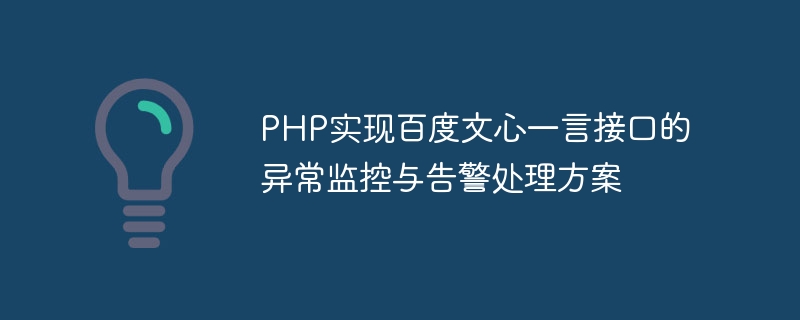Home >Backend Development >PHP Tutorial >PHP implements the abnormal monitoring and alarm processing solution of Baidu Wenxin Yiyan interface
PHP implements the abnormal monitoring and alarm processing solution of Baidu Wenxin Yiyan interface
- WBOYWBOYWBOYWBOYWBOYWBOYWBOYWBOYWBOYWBOYWBOYWBOYWBOriginal
- 2023-08-26 18:41:06861browse

PHP implements the abnormal monitoring and alarm handling solution of Baidu Wenxin Yiyan interface
- Introduction
Baidu Wenxin Yiyan is an interface that provides random sentences Public interface, many websites will display these sentences on the page to increase the literary and artistic atmosphere of the website. However, due to the instability of the network environment and occasional server failures, it is likely that the Baidu Wenxin Yiyan interface cannot be accessed normally, thus affecting the normal operation of the website. In order to ensure the stability of the website, we need to monitor the Baidu Wenxin Yiyan interface for exceptions and handle alarms in a timely manner. - Abnormal monitoring solution
In order to realize abnormal monitoring of Baidu Wenxin Yiyan interface, we can judge the availability of the interface by regularly accessing the interface and monitoring the return status code. If the status code returned by the interface is not 200, it means that there is an exception in the interface access. We can use the curl function in PHP to access the interface and obtain the returned status code through the curl_getinfo function.
The following is a simple code example:
<?php
// 定义百度文心一言接口URL
$apiUrl = 'https://v1.hitokoto.cn/';
// 初始化一个curl会话
$curl = curl_init();
// 设置curl选项
curl_setopt($curl, CURLOPT_URL, $apiUrl);
curl_setopt($curl, CURLOPT_RETURNTRANSFER, true);
curl_setopt($curl, CURLOPT_FOLLOWLOCATION, true);
// 发送请求并获取返回的状态码
$response = curl_exec($curl);
$httpCode = curl_getinfo($curl, CURLINFO_HTTP_CODE);
// 关闭curl会话
curl_close($curl);
// 判断接口返回的状态码是否为200
if ($httpCode != 200) {
// 接口访问异常,进行告警处理
sendAlert();
}
// 解析接口返回的JSON数据
$data = json_decode($response, true);
echo $data['hitokoto'];In the above code, we send the request through the curl function and use the curl_getinfo function to get the returned HTTP status code. If the status code is not 200, it means that the interface access is abnormal, and we can handle the corresponding alarm here.
- Alarm processing solution
When an interface exception occurs, we need to handle the alarm in a timely manner in order to respond quickly and solve the problem. We can use PHP's email sending function to send alerts by sending emails.
The following is a simple code example:
<?php
// 发送告警邮件
function sendAlert()
{
// 收件人邮箱
$to = 'alert@example.com';
// 邮件主题和内容
$subject = '百度文心一言接口访问异常';
$message = '百度文心一言接口访问异常,请及时处理!';
// 发送邮件
mail($to, $subject, $message);
}In the above code, we send the email through the mail function, where the $to variable is the recipient's email address and $subject is the subject of the email, and $message is the content of the email.
By combining the above-mentioned exception monitoring solution and alarm processing solution, we can realize abnormal monitoring of Baidu Wenxin Yiyan interface, and perform alarm processing in a timely manner to improve the stability and reliability of the website.
Summary
This article introduces how to use PHP to implement anomaly monitoring and alarm handling solutions for Baidu Wenxin Yiyan interface. By regularly accessing the interface and monitoring the returned status code, we can determine the availability of the interface and handle alarms through emails. This can ensure the stability of the website and avoid abnormal interface access causing the website to not operate properly. I hope this article can help with the solution of using PHP to implement interface exception monitoring and alarm handling.
The above is the detailed content of PHP implements the abnormal monitoring and alarm processing solution of Baidu Wenxin Yiyan interface. For more information, please follow other related articles on the PHP Chinese website!
Related articles
See more- How to make Baidu homepage with html
- Baidu Xiongzhanghao resource platform URL link submission using the curl command push example (installation and configuration graphic steps)
- PHP uses Baidu Map to obtain the coordinates of the specified address: longitude and latitude (image, text + video)
- what is python? (Baidu Encyclopedia)

